Betta fish are becoming increasingly popular each day as they are colorful pet fish. Betta fish have been selectively produced over the years to produce a wide variety of beautiful fish. So there are many betta fish types. they can be groped by various factors including betta tail types.
So many different types of beta fish from patterns, and colors can be overwhelming for an outsider. The number of variants is confounding even the experienced beta fish keepers. The guide will help you recognize all betta fish types by their tail variations. If you are trying to decide what kind of beta to buy as your first pet, or what kind of beta to breed, then this knowledge is for you.
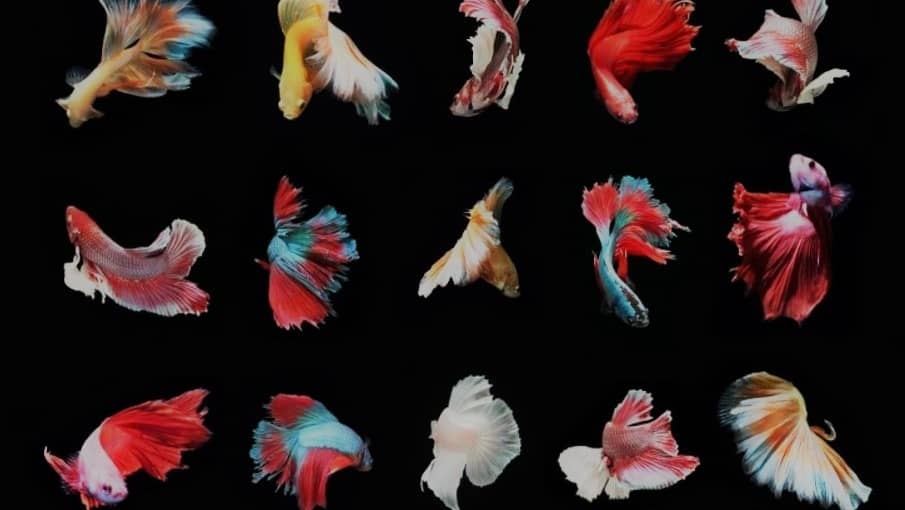
Types of Betta Fish By betta tail types
Jump To
- 1 Types of Betta Fish By betta tail types
- 2 03. Veiltail Betta.
- 3 04. Double Tail Veiltail Betta
- 4 05. Spade tail Betta
- 5 06. Roundtail Betta
- 6 07. Delta Tail And Super Delta Betta
- 7 08. Halfmoon Betta And Over-Halfmoon Betta
- 8 09. Fullmoon Betta
- 9 10. Rosetail Betta
- 10 11. Feathertail Betta
- 11 12. Asymmetrical Halfmoon Plakat Betta
- 12 13. Symmetrical Halfmoon Plakat Betta
- 13 14. Double Tail Plakat Betta
- 14 15. Crowntail Bettas
- 15 16. Double tail Crowntail Betta
- 16 17. Crowntail Plakat Betta
- 17 18. Dumbo Betta
- 18 19. Giant Betta
- 19 Conclusion Types of Betta Fish By Betta Tail Types
01. Plakat (PK) or Wild Betta.
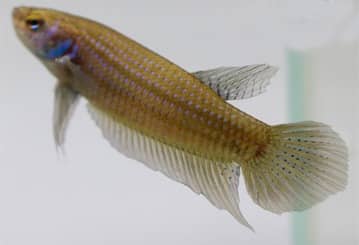
Wild Betta Splendens is a fantastic fish by itself, with its dark body and luxurious red and multicolor fin. Wild betta fish carry two copies of the short-fin allele. It is a recessive allele and causes bettas to have short fins. Because the term given to domesticated short-fin bettas is ‘plakat’ this gene is also sometimes referred to as the plakat allele.
How to identify Plakat (PK) or Wild Betta
The unpaired fins are short, but the ventrals are relatively thin and long. The dorsal fin is rounded or slightly pointed to the rear. The caudal fin is rounded or slightly pointed in the middle, and each caudal ray only splits in two once before reaching the edge of the fin (primary branching). The first rays of the caudal fin (at the top and bottom of the fin) are rounded and often relatively short; and The anal fin is trapezoid in shape, shorter at the front and pointed at the rear, with the tip extending beyond the lower edge of the caudal fin.
02. Traditional Plakat Betta.

The traditional plakat is similar to a wild Betta because traditional plakats are show fish. Their finnage is usually a bit longer than that seen in wild Betta.
How To Identify Traditional Plakat Betta
As with wild bettas, this breed is asymmetrical, meaning that the rear tip of the anal fin extends beyond the bottom of the caudal fin. Unlike the majority of wild and wild-type plakats, traditional plakats can, as a result of selective breeding, have 180˚or more between the upper and lower caudal rays. The critical difference between these bettas and the show bettas is that the first rays will curve strongly towards the end of the caudal fin. Traditional plakats, as with wild and wild-type plakats, have two copies of the short-fin allele.
The unpaired fins are short, but the ventrals are relatively thin and long (approximately two-thirds the length of the body). The dorsal fin is rounded or slightly pointed to the rear. The caudal fin is rounded or pointed somewhat in the middle (spade-shaped), and each caudal ray only splits in two once before. Reaching the edge of the fin (primary branching). The first rays of the caudal fin (at the top and bottom of the fin) are rounded and often relatively short; and The anal fin is trapezoid in shape, shorter at the front and pointed at the rear, with the tip extending beyond the lower edge of the caudal fin.
03. Veiltail Betta.

The veiltail is the standard beta type. The fish, most people, think of when listening to the words ‘ Siamese fighting fish.
How To Identify Veiltail Betta
Male veiltails have a very characteristic appearance and are almost impossible to misidentify. Female veiltails can be harder to distinguish accurately, as in some cases they resemble females of other breeds. There are, however, some key characteristics that can help you to identify a female veiltail.
Male Veiltail Betta
Male have unpaired fins, and ventral fins are long and flowing. The dorsal and anal fins are shorter at the front than at the back and often longer than the fish’s body. The upper rays of the caudal fin are markedly more curved than those lower down the fin. Giving the caudal fin a hump-backed appearance.
Female Veiltail Betta
Females have unpaired fins that resemble shortened versions of the long flowing fins seen in males, with a similar shape. The caudal fin shows primary branching, does not spread very wide and is often shaped like an almond or a piece of sweetcorn.
The anal fin rays are usually longer than the caudal fin rays, particularly at the rear of the fin. The consensus among betta enthusiasts is that the veiltail trait in bettas is the result of a single genetic mutation that resulted in an increase in length.
04. Double Tail Veiltail Betta

Double tail veil tail bettas, like their single tail counterparts, are hard to mistake thanks to their two long, roughly almond-shaped tails, placed one above the other.
Male Double Tail Veiltail Betta
The Male has unpaired fins, and ventrals are long and flowing. The fish has two caudal lobes. The dorsal fin is similar in size to the anal fin. The dorsal and anal fins are shorter at the front than at the back and often longer than the fish’s body. The inner rays of each caudal lobe are more curved than the outer rays. As a result, the two tails appear to bend away from each other. The caudal rays only split in two once before reaching the outer edge of the fin (primary branching).
Female Double Tail Veiltail Betta
The Female resembles a shortened version of the male’s fins. The fish has two caudal lobes, neither of which spread unusually wide and both of which are somewhat almond-shaped. The dorsal fin is as broad and wide as the anal fin. The caudal rays only split in two once before reaching the outer edge of the fin (primary branching). The anal and dorsal fin rays are longer than the caudal fin rays.
05. Spade tail Betta

The Spadetail bettas are a variation of veiltail; Male spadetail bettas have caudal fins shaped like a spade as in the suit in a deck of cards
Male Spadetail Betta
The male has a Spade-shaped caudal fin. All other characters are identical to male veiltail.
Female Spadetail Betta
The female Occasionally females have a spade-shaped caudal fin. But more commonly they are indistinguishable from female veiltails.
06. Roundtail Betta

The round tail is the term given to any single-tailed long-finned beta with a rounded top and bottom edges to its caudal fin, giving a round appearance to the tail. The effect is caused by the upper and lower caudal branches curving downwards and upwards respectively to give a ‘C’ shape.
Male Roundtail Betta
The male has a rounded caudal fin. Can have primary branching. The female has a rounded caudal fin.
Female Roundtail Betta
Female round tails are hard to distinguish from females of several other tail types, as the curved caudal rays can make them resemble short-finned betta breeds.
07. Delta Tail And Super Delta Betta

Delta tail and super delta bettas are two common types of tails that are often used in attempts to breed half-moon bettas. The males have long fins with straight caudal rays. An angle of up to 150˚ between the upper and lower caudal rays.
How To Identify How To Delta Tail And Super Delta Betta
Delta Tail Males
The angle of 150˚ to 175˚ between the upper and lower caudal rays.
Super Delta males
All unpaired fins are of approximately equal length and often no overlap between the rear edge of the anal fin and the caudal fin when the fish is the view from the side.
Super Delta Female
The Female has short fins with straight caudal rays. The caudal fin has tertiary branching and delta or super delta spread. The anal fin is roughly rectangular, extending beyond the edge of the caudal fin.
08. Halfmoon Betta And Over-Halfmoon Betta

The halfmoon bettas are the most famous breed. Male Halfmoon provides a large area in their big fins to showcase the beautiful colors and color patterns in bettas.
Male Halfmoon Betta
The male has long fins with straight rays. At least quaternary branching in the caudal fin. An angle of 180˚ (plus or minus 5˚) between the upper and lower caudal rays. All unpaired fins of approximately equal length and, when fully spread, overlap so that there are no gaps between the unpaired fins when the fish is the view from the side.
Female Halfmoon Betta
The female fish have short fins with straight rays. Caudal fin with at least tertiary branching and super delta or Halfmoon spread. Anal fin is roughly rectangular, extending beyond the edge of the caudal fin.
09. Fullmoon Betta
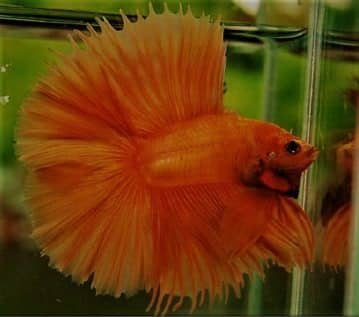
The full moon betta is similar to the double veiltail, double tail Halfmoon bettas have two caudal lobes, which ideally should be of equal size to one another and have a split between them, extending to the caudal peduncle.
How To Identify Fullmoon Betta
The dorsal fin usually has twice the number of fin rays of a typical single tail betta and should nicely mirror the anal fin in length and width to give the fish a symmetrical appearance. As with all other breeds, the fins should be in proportion to the body size, to provide a fish with a balanced appearance, and the fish should carry the fins with ease. Doubletail halfmoons have the most finnage of any of the betta breeds.
10. Rosetail Betta

The rosetail bettas are characterized by excessive branching in all three of the unpaired fins.
How To Identify Rosetail Betta
In the caudal fin, the rosetail trait usually manifests itself as a minimum of 16 rays per branch at the caudal edge and a caudal spread of over 180˚. The result of this excessive branching is that the fins take on a ruffled appearance, which can often look like the overlapping petals of a flower. This overlapping petals effect is where the term ‘rosetail’ comes from. Although they can be gorgeous, rosetail bettas are something of a double-edged sword when it comes to breeding.
Male Rosetail Betta
The male betta has long ruffled fins with straight caudal rays, At least quinary branching in the caudal fin (16 rays at the caudal edge).An angle of 180˚ or more between the upper and lower caudal rays. All unpaired fins are of approximately equal length and, when fully spread, overlap so that there are no gaps between the unpaired fins when the fish is the view from the side.
Female Rosetail Betta
The female betta has Short ruffled fins with straight caudal rays. At least quaternary branching in the caudal fin; Anal fin rays are often slightly long than caudal fin rays. Some females have super delta or Halfmoon caudal spread.
11. Feathertail Betta

Feathertail bettas are rosetails that are extreme. They are very rare, as any serious attempt to produce feathertails will produce a lot of extreme rose tails, resulting in most of the spawn ending up removing.
How To Identify Feathertail Betta
The caudal ray branching is so extensive that the caudal fin looks for all the world as though it is made up of individual feathers arranged into a fan. The genetics of feathertail bettas are the same as of rosetails.
12. Asymmetrical Halfmoon Plakat Betta
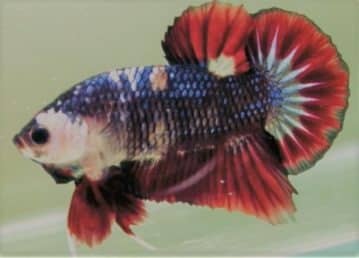
The asymmetrical halfmoon plakat combines the primary form of a traditional plakat with the additional caudal spread and caudal ray branching of a halfmoon and a rounded tip to the rear of the anal fin. In terms of behavior, however, they are more similar to wild-type or traditional plakats. They are referred to as asymmetrical because if you draw an imaginary horizontal line through the fish.
The top half does not mirror the bottom half, on account of the anal fin extending beyond the bottom of the caudal.
Male Asymmetrical Halfmoon Plakat Betta
The male betta has unpaired short fins, and the ventrals are generally broader and shorter than traditional plakat. The dorsal fin is roughly semi-circular and snaps open like a fan, ideally with the first rays being of similar length to the rest of the dorsal rays and pointing forwards towards the head of the fish.
The caudal fin has at least tertiary branching (four rays at the caudal edge) and a spread of 180˚. The caudal rays are straight, and ideally, the top and bottom points of the fin are sharp, not rounded. The anal fin is trapezoid in shape, shorter at the front and longer at the rear, extending beyond the lower edge of the caudal.
Female Asymmetrical Halfmoon Plakat Betta
Females have shorter fins than males, but the same ideas apply in terms of fin shape.
13. Symmetrical Halfmoon Plakat Betta
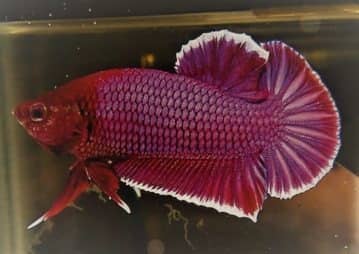
Also known as the short-fin halfmoon, or short moon, the symmetrical halfmoon plakat is generated to integrate all the long-finned halfmoon. As with long-finned halfmoons, the goal is symmetry. Hence the name symmetrical: If you draw a horizontal line through the fish, the top half will more or less mirror the bottom half (ignoring the ventral fins).
In terms of form, symmetrical Halfmoon plakats should meet the same criteria as their long-finned Halfmoon counterparts. As with asymmetrical Halfmoon plakats, because good symmetrical halfmoon plakats have a caudal spread of 180˚, they are commonly sold under the catch-all names of Halfmoon plakat.Types of Betta Fish By Betta Tail Types
Male Symmetrical Halfmoon Plakat Betta
The male betta has unpaired short fins. The ventrals are full and relatively short to maintain the overall balance of the betta’s fins. The caudal fin is D-shaped with at least secondary branching (four rays at the caudal edge) and a spread of 180°. The caudal rays are straight. The tail fin ideally has sharp corners at the top and bottom. The anal fin is roughly rectangular in shape and similar in size and shape to the dorsal. It ideally should not extend beyond the bottom of the caudal.
Female Symmetrical Halfmoon Plakat Betta
The females are similar to males but have shorter unpaired fins and short ventrals.
14. Double Tail Plakat Betta

There are doubletail versions of both the asymmetrical and symmetrical halfmoon plakat, which are simply halfmoon plakats that carry two copies of the doubletail gene.
How To Identify Doubletail Plakat Betta
In such fish, the idea is to produce betta with two even caudal lobes in a D-shape, with either asymmetrical or symmetrical dorsal and anal fins, depending on the goal.
15. Crowntail Bettas

Crowntail bettas are characterized by having significantly reduced webbing between the rays of all three unpaired fins. The fin rays protrude beyond the edge of the webbing, giving the fin a spiky appearance like a crown. There are variations of Crowntail. This is because breeders have succeeded in producing several variations of crowntail, all of which have been given names to help identify the traits they exhibit.
Types Of Crowntail Bettas
Single-Ray Crown Tail Betta
These fish exhibit primary branching and have the same degree of webbing reduction between the primary fin rays as between the secondary rays, such that the webbing is in the shape of a semi-circle, with individual ray ‘spikes’ of roughly equal length extending beyond the webbing.
Double-Ray Crown Tail Betta
They differ from single-ray crown tails in that the webbing reduction is greater between the primary caudal rays than between the secondary rays. As a result, the secondary branches are conjoined, near the base, and project as a pair of spikes from the rest of the caudal fin. The Double-Ray Crown Tail Bettas is probably the most commonly seen type of crown tail.
Double-Double-Ray Crowntail Betta
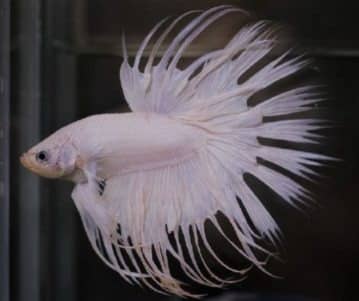
This fish is similar to the Double-Ray Crown Tail Bettas, except that instead of having two conjoined spikes emerging from the rest of the fin, it has four; the result of the fish in question having tertiary branching. Now things get more interesting: Through selective breeding, breeders were able to produce Double-Ray Crown Tail Betta in which the two spikes were curved away from one another.
By working to maximize this effect, they created the first cross-ray crown tails, because the central peaks of the caudal fin cross one another. This fish is the most popular crowntail form of all and enjoys the lofty title of king crown tail.
Male Double-Ray Crown Tail Betta
The male betta has unpaired fins long, of equal length, and shows at least a 33% reduction in fin webbing. The ventrals are spiky, thin, and long. The caudal fin has secondary or tertiary branching (two or four rays at the caudal edge) and ideally a spread of 180˚; The primary caudal rays are ideally straight.
Female Double-Ray Crown Tail Betta
The female betta is similar to males but has shorter unpaired fins, short ventrals, and fin webbing reduction to at least 25%.
16. Double tail Crowntail Betta
These fish are very hard to perfect, as the ideal double tail crowntail should have the form of an excellent double tail halfmoon, with the webbing reduction of a good crowntail. Because they are such a challenge to produce, double-tail crown tails are very rarely seen in the hobby.
17. Crowntail Plakat Betta
One of the newest breeds in the hobby .which is essentially a shortfin version of the standard crowntail. As with all breeds, the aim is to produce a balanced fish, and in the case of crowntail plakats. It is desirable to have a fish that is more symmetrical in appearance so that the anal fin does not extend beyond the length of the caudal fin rays.
The crowntail plakat is a unique challenge for a breeder because it is not easy to achieve the same level of webbing reduction in all three unpaired fins.
18. Dumbo Betta

Dumbo (elephant ear bettas) has characteristic opaque elongated pectoral fins. They are named dumbo because from the front the fins look like big elephant ears sticking out of the sides of the head. It is now a common type of betta fish
Most of the time dumbo pectoral fins have been bred into long and shortfin Halfmoon betta fish, and this phenotype is most commonly found in bettas with ‘salamander’ coloration. Still, now we have seen dumbos in gold, pineapple, and platinum white.
Because dumbos exist in shortfin and longfin forms (with respect to the unpaired fins and ventrals), the ideal form for these fish and the methods for telling apart males and females are the same as they would be for the fish if they did not have the enlarged pectoral fins.
The dumbo gene is recessive, affects only the pectoral fins and behaves predictably, such that fish with two copies of the gene have dumbo pectorals and fish with only one copy have normal pectorals.
19. Giant Betta

They are BIG types of betta fish some of which can be over 3.5” long so the name is giant betta. Experiments were undertaken by Dr Gene Lucas when giant bettas first appeared. The hobby suggested strongly that a partially dominant gene might produce the giant phenotype.
As bettas inheriting one copy of the ‘giant gene’ grew larger than normal bettas (so-called ‘half-giants’). Bettas carrying two copies of the gene grew to be giants.
Conclusion Types of Betta Fish By Betta Tail Types
So I think now you have a good idea of how to identify betta fish from betta tail types and types of betta fish.
See the guide on Black Ghost Knifefish
